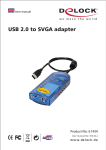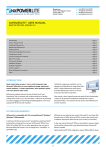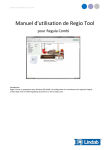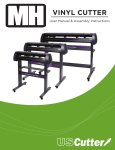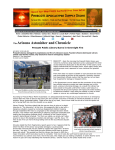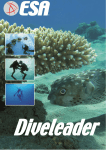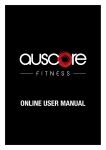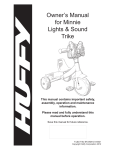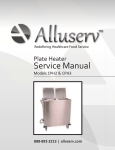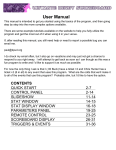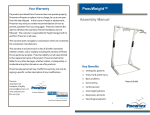Download User Manual - Finishing Fitness, Inc.
Transcript
User Manual Finishing Fitness Inc. (513) 312‐1615 | finishingfitness.com Table of Contents Introduction…………………………………………………………………...03 Notes For Proper Use……………………………………………………...05 Finishing Motions…………………………………………………………….06 Finishing Your Core…………………………………………………………..14 Finishing Your Legs…………………………………………………………..19 Whole Body Finishing………………………………………………………22 The Beginner Workout…..………………………………………………...26 The Intermediate Workout………………………………………………27 The Advanced Workout…………………………………………………...28 “Copyright © 2012, Finishing Fitness Inc. All rights reserved.” 2 Background – In July of 2010, following my third neck surgery, I quickly no ced that my le shoulder was weak and sore. A er a few days I went back to my surgeon and described the pain and rapidly declining strength. He soon concluded that I was one of the unlucky few who came out of surgery with C‐5 palsy. Basically, the nerve that feeds the shoulder area suffered damage and there was no guarantee as to how much the shoulder would recover, if at all. He recommended that I begin physical therapy immediately to prevent further muscle loss, and hope the nerve started doing its job again. A er months of physical therapy I had improved to about 50% of my original strength and mo on. My physical therapist and I decided it was just going to take a long me and I should strive to make progress on my own with periodic checkups to monitor progress. I’ve been an ac ve coach and somewhat of a “fitness freak” most of my life. So working out to strengthen my shoulder was really not going to be anything new for me. However, I never had to pay so much a en on to a muscle that simply would not do what I thought it should be able to do. With that in mind, I began working out and always looking for a new way to exercise and strengthen my stubborn shoulder. That’s when I developed what I call “Finishing”. I simply took the term from what I knew about my experience with handyman and construc on work. Over the years I’ve occasionally had the opportunity to finish concrete. This gave me the idea of trying to simulate the mo ons used when finishing concrete to help develop and strengthen my weakened shoulder. As me went on I implemented many of the same mo ons concrete finishers use but in a controlled and organized fashion. These mo ons proved to be highly effec ve with working not only my shoulder, but ul mately, my en re body. I believe I have created an exercise process and product that will impress and challenge even the fi est of fitness gurus. The Finisher and Finishing revolu onize exercise from the days of isolated movements with li le func onal purpose, i.e. bicep curls, to a highly dynamic and func onal exercise. Athletes in all physical ac vi es find superior benefits from employing the dynamic use of The Finisher. With Finishing, you are using the muscles of the back, shoulders, chest, arms, bu ock and legs. With The Finisher, you employ a func onal dynamic that requires a person to make adjustments in load and stabiliza on, as well as accelera on, (change in speed and direc on). This requirement, in addi on to the mandate of trunk and cervical stabiliza on while performing the exercises, yields the highest degree of func onal exercise from the simplest of movements. I know you will find The Finisher and the prac ce of Finishing, to be as effec ve and enjoyable, as I have found it to be. Good luck and enjoy! “Copyright © 2012, Finishing Fitness Inc. All rights reserved.” 3 The Finisher and the exercise of Finishing, comes with several terms you need to know. Finishing – derived from the work of “finishing” concrete. Finishing concrete often involves using hand tools to create a concrete surface of a desired texture, smoothness and durability. As an exercise, we simulate many of these same motions. This practice involves the use of shoulders, upper and lower back, chest, arms, abdomen, buttock, and thighs. The Finisher - A board or mat covered with a smooth and durable sliding surface in which the user simulates the many different motions and exercises in the routine of Finishing. *Note – The Finisher may be used at many different heights ranging from ground level to chest level. It may also be used on a variety of angles from 0 degrees to 90 degrees. Heights and angles of use are determined based on the user’s goals. Waist Level Knee Level Floor Level “Copyright © 2012, Finishing Fitness Inc. All rights reserved.” 4 Notes on Proper Form and Use CAUTION * Before beginning any exercise routine, please consult your doctor to determine your overall level of fitness and health to determine the appropriate level of exercise for your fitness level. * If at any time you feel dizzy, shortness of breath, unusual muscle or joint pain, immediately stop exercising. If conditions persist, seek medical attention. * Range of motion for finishing exercises is to be determined by the individual user. Everybody has slightly different range capabilities based on muscle and joint structure and flexibility. Exceeding one’s natural range of motion places the user at greater risk for injury. When using The Finisher, it is important to work from a stable body position, i.e. athletic stance. Plant your feet firmly on the ground with knees slightly bent. Keep your back and neck in a straight and neutral position. If using on the floor it is highly recommended to use knee padding as your knees will be the primary base of support for your body. When using right or left arm as a post for stability be sure that the arm and hand are in a comfortable but stable position to support the body. While sliding the weight refrain from sloppy motion of the body. Keep your head neutral, while looking down and your back in a straight line. While sliding the weight past the midline of your body, keep your thumbs pointing as straight ahead as possible. Helping to reduce the risk of shoulder impingement. While sliding the weight, move at a comfortable pace while staying in control with each slide. Do not move the weight in a rushed or hurried motion to a degree that you do not have sufficient control of the weight. Doing such could lead to injury or muscle strain. Concentrate on keeping your body in control and with a stable base to balance the motion of the sliding weight. 5 Finishing Motions Finishing The Arms, Chest, Shoulders, Back, Abs, and Upper Legs Push Pull – Sliding the dumbbells up and down parallel to each other at the same me. Allow arms to bend as they come back to the body, keeping elbows close to each side of your body. Do not permit the weights to slide behind or past your torso. Then thrust the weight forward by extending the arms. Ladder Climbing – Sliding the dumbbells up and down parallel to each other at the opposite me. Allow arms to bend as they come back to the body, keeping elbows close to the each side of your body. Do not permit the weight to slide behind or past your torso. Then thrust the weight forward by extending the arm. 6 Finishing Motions Finishing The Arms, Chest, Shoulders, Back, Abs, and Upper Legs Right Arm Sweep – Pos ng the le arm, slide the right arm from side to side across the mid‐line of the body. Le Arm Sweep – Pos ng the right arm, slide the le arm from side to side across the mid‐line of the body. 7 Finishing Motions Finishing The Arms, Chest, Shoulders, Back, Abs, and Upper Legs Right Arm 45’s – Pos ng the le arm for stability while sliding the right arm back and forth at a 45 degree angle. Le Arm 45’s – Pos ng the right arm for stability while sliding the le arm back and forth at a 45 degree angle. Right Arm 45’s (opp) – Same as Right Arm 45’s but moving at 180 degrees . Le Arm 45’s (opp) – Same as Le Arm 45’s but moving at 180 degrees. 8 Finishing Motions Finishing The Arms, Chest, Shoulders, Back, Abs, and Upper Legs Right Arm Edger – Locate parallel to The Finisher with your right hip next to the bo om edge of The Finisher, post the le arm on the floor while using the right arm to slide the weight across the surface. This exercise enhances the use of the bicep and tricep muscles. Push the weight past your hip and return by bending the elbow. Le Arm Edger – Locate parallel to The Finisher with your right hip next to the bo om edge of The Finisher, post the le arm on the floor while using the right arm to slide the weight across the surface. This exercise enhances the use of the bicep and tricep muscles. Push the weight past your hip and return by bending the elbow. 9 Finishing Motions Finishing The Arms, Chest, Shoulders, Back, Abs, and Upper Legs Right Arm Circle (le ) – Pos ng on the le arm, circle the right arm in a counter‐clockwise mo on, (le ). Le Arm Circle (right) – Pos ng on the right arm, circle the le arm in a counter‐clockwise mo on, (right). Right Arm Circle (right) – Pos ng on the le arm, circle the right arm in a clockwise mo on, (right). Le Arm Circle (le ) – Pos ng on the right arm, cir‐ cle the le arm in a clockwise mo on, (right). 10 Finishing Motions Finishing The Arms, Chest, Shoulders, Back, Abs, and Upper Legs Both Arm Circle (inside) – Moving both arms at the same me in large circles toward each other, (inside). Both Arm Circle (outside) – Moving both arms at the same me in large circles away from each other, (outside). 11 Finishing Motions Finishing The Arms, Chest, Shoulders, Back, Abs, and Upper Legs Right Arm Wiper – Pos ng with the le arm, place right elbow on the surface and move hand right to le in an arc mo on, (wiper). Keep the angle between the shoulder and hand greater than 90 degrees. The range of mo on is determined by the user. If it feels uncomfortable or painful, do not go to that point. Le Arm Wiper – Pos ng with the right arm, place le elbow on the surface and move hand right to le in an arc mo on, (wiper). Keep the angle between the shoulder and hand greater than 90 degrees. The range of mo on is determined by the user. If it feels uncomfortable or 12 Finishing Motions Finishing The Arms, Chest, Shoulders, Back, Abs, and Upper Legs Right Arm Arc – Using the le arm for stability, move the right arm in a large arc with the arm only slightly bent. Le Arm Arc – Using the right arm for stability, move the le arm in a large arc with the arm only slightly bent. 13 Finishing Your Core CAUTION Choose a weight that you are comfortably able to slide from side to side. It is recommended that in your ini al core workouts lighter weight is be er than heavier weight. More important than weight is the emphasis placed on quality form and stability while performing the exercises. Persons with back and spinal problems should only a empt these exercises under the strict supervision of a trained professional. If pain or discomfort is experienced - immediately stop exercising. If condi ons persist, please seek medical a en on. Failure to use proper form and heed warnings may result in personal injury. Torso exercises use many of the same mo ons previously described. However, emphasis is now placed on keeping the arms locked in a comfortable but straight posi on. The legs are also locked in a comfortable but straight posi on forming a firm base of support. The movement originates from the torso. Speed is not important. Move at a comfortable pace without rapid jerking or twis ng. 14 Finishing Your Core TORSO ARC Torso Arc – Firmly holding the weight and making sure your base is strongly supported, begin by sliding the weight in an arc mo on from right to le with the use of your torso. Emphasis is placed on the mo on coming from the torso, not the arms. 15 Finishing Your Core TORSO SWEEP TORSO PUSH PULL Torso Sweep ‐ Firmly holding the weight and making sure your base is strongly supported, begin by sliding the weight from right to le with the use of your torso. Emphasis is placed on the mo on coming from the torso, not the arms. Torso Push Pull ‐ Firmly holding the weight and making sure your base is strongly supported, begin by sliding the weight up and down, (push‐pull), with the use of your torso. Emphasis is placed on the mo on coming from the torso not the arms. 16 Finishing Your Core TORSO CIRCLES Torso Circles ‐ Firmly holding the weight and making sure your base is strongly supported, begin by sliding the weight in complete circles. (Switch direc on and perform an equal number of circles). Emphasis is placed on the mo on coming from the torso not the arms. 17 Finishing Your Core Torso Twist (right side) – Locate parallel to the board, place your right hand on the weight. Begin by sliding the weight back and forth in an arc mo on. Emphasis is placed on standing with a straight back and keeping the right arm comfortably straight. Do not inten onally use the muscles of the arm to move the weight. Rather, all the movement is coming from the twis ng of the torso. Torso Twist (le side) ‐ same as above with le side parallel to the board 18 Finishing Your Legs CAUTION Choose a weight that you are comfortably able to slide from side to side. It is recommended that in your initial leg workouts lighter weight is better than heavier weight. More important than weight is the emphasis placed on quality form and stability while performing the exercises. Range of motion for finishing exercises is to be determined by the individual user. Everybody has slightly different range capabilities based on muscle and joint structure and flexibility. Exceeding one’s natural range of motion places the user at greater risk for injury. If pain or discomfort is experienced - immediately stop exercising. If conditions persist, please seek medical attention. Failure to use proper form and heed warnings may result in personal injury. Finishing with your legs involves many of the same mo ons previously described. However, when doing these mo ons the user emphasizes work from the legs rather than arms or torso. Leg finishing is done with The Finisher in an elevated posi on. i.e. knee‐waist. Bounding – side to side – Place hands on dumbbells and square up to the board. Begin by extending the weight out with your right arm and in toward your body with your le arm in an alterna ng fashion. As you extend the right arm, move your bodyweight over your right leg. Then pull the right arm in and extend the le arm while transferring your bodyweight over the le leg. Once you become comfortable with this mo on you can increase your speed while exploding from one leg to the other. 19 Finishing Your Legs Push Pull Squats – Square up to The Finisher and place both hands on the weights. Simply drop down while keeping your back straight and bending your legs to form a 90 degree bend. The weights will extend away from the body because the arms are straight and comfortably locked. Once the upper leg is parallel to the ground, drive straight up to a standing posi on. Do not li the weights off the surface. Speed Skaters – Placing emphasis on extending your arms out to the side edges of the board in alterna ng fashion. When your arms extend to the far side transfer your body weight over to the leg on the same side. Keep your back straight and bend your leg to nearly a 90 degree bend. Drive from the down posi on in order to change the direc on of mo on to the other side and dropping your weight over your opposite leg. The mo on is similar to a speed skater, driving from one leg to the other. 20 Finishing Your Legs Sliding lunges (right side) – Standing with your right side next to the board, place your hand on the weight and step out with your le leg. As you step and move forward, slide the weight with your arm to the edge of the board. This provides some resistance, but offers excellent stability. Once your le leg is fully extended, bend your le leg so that your upper leg becomes as close to parallel to the ground as possible. The right leg should remain comfortably straight while dropping un l the right knee touches the ground. Sliding lunges (le side) – Same as above with your le side next to the board. 21 Whole Body Finishing All exercises performed with The Finisher on the floor. Sliding Squat Thrust – Place yourself in an upright push‐up posi on with your legs extending onto The Finisher. (Sliding pads are placed squarely under your feet). Slide both feet toward your chest. Once you’ve pulled them as ght to your chest as you can, extend them un l fully straightened over The Finisher. Repeat using mer or coun ng repe ons. Sliding Mountain Climbers – Place yourself in an upright push up posi on with your legs extending on to The Finisher. (Sliding pads are placed under your feet) Slide one foot toward your chest while the other leg remains extended. Once you’ve pulled the leg to the chest, extend it as you bring the other leg toward the chest. Alternate this mo on for a set interval me or count your repe ons. 22 Whole Body Finishing All exercises performed with The Finisher on the floor. Sliding Hip Thrust – Laying on your back with your legs extended over The Finisher, bring your feet up toward your bu ock un l your feet are flat on the floor. Drive your hips straight up from the ground with your hips being 3‐5 inches off the ground. One leg at a me, extend a leg by sliding it out on the slider pad. As you do, allow your foot to roll up on the heel of the foot. The opposite leg remains in a stable pos ng posi on. Once the leg is fully extended, pull it back to the bu ock and slowly begin extending the opposite leg in the same fashion. Alternate this mo on for a set interval or count your repe ons. 23 Whole Body Finishing All exercises performed with The Finisher on the floor. Sliding Squat Thrust with a Twist – Perform as squat thrust above, but as you pull your legs up toward your chest, bring both legs across the body and toward the right arm. Then fully extend both legs and pull legs up under the body toward the le arm. Alternate this mo on for a set interval or count your repe ons. One leg Slide (right) – Standing next to The Finisher with your right foot on the board and your le foot on the floor. Begin by keeping the back straight and in a neutral posi on. Squat down on the le leg while the right leg remains straight and is pushed out across the board. Once you have dropped to a one leg squat posi on, drive up and pull the sliding right leg back to the body. Do a set number of repe ons or a med interval. One leg Slide (le ) – Same as above but with your le leg on The Finisher and your right leg on the floor. 24 Finishing for Fitness The following pages are examples of workouts for the beginner, Intermediate and advanced users. CAUTION * Before beginning any exercise routine, please consult your doctor to determine your overall level of fitness and health to determine the appropriate level of exercise for your fitness level. * If at any time you feel dizzy, shortness of breath, unusual muscle or joint pain, immediately stop exercising. If conditions persist, seek medical attention. * Range of motion for finishing exercises is to be determined by the individual user. Everybody has slightly different range capabilities based on muscle and joint structure and flexibility. Exceeding one’s natural range of motion places the user at greater risk for injury. 25 The Beginner’s Workout The Beginner workout assumes the user has little to no experience with the Because The Finisher recruits the use of many muscles used in the various planes of mo on of the shoulders, back, arms, chest, abdomen, bu ock, and thighs, it is essen al to start slowly to allow muscles that seldom get used to develop and strengthen to accommodate greater stress loads. To do this, it is recommended to start with a lighter weight and work for shorter intervals. Be pa ent, in just a few short weeks you will find yourself feeling stronger and more stable throughout your body. The average person with no history of muscle or joint injury may choose to start with 8 – 12 lbs dumbbells and working for only 20 second intervals. Star ng with an even lighter weight is fine especially if you are warming up or new to Finishing. A er using The Finisher two – four mes you may begin to increase weight or work interval or both. A general rule to remember when determining how heavy the weight should be is by observing how smoothly you are able to move the weight; if the weight feels heavy and you find yourself using poor posture and jerky mo ons, then you may be using too much weight, drama cally increasing the risk of injury. Round One ‐ The Warm Up – To begin, choose an appropriate weight and set your interval mer for 20 – 30 seconds. Then start the mer and follow the sequence of mo ons atop The Finisher. It is not necessary to count your repe ons, but rather concentrate on making smooth and full range mo ons. Do not rush the mo ons or move too slowly. Move at a comfortable pace. A er the interval alarm alerts, move to the next mo on. Emphasis should be placed on moving and loosening the muscles and joints in order to warm the muscles and increase blood flow to the working joints. Round Two ‐ The Workout ‐ A er a good round of warming up, choose the appropriate weight to start the next round. You may keep your interval me at 20 seconds, or possibly adjust it to 30 seconds. Once you set the interval mer, start the mer and follow the sequence of mo ons atop The Finisher. As in the warm‐up, do not concern yourself so much with the number of repe ons, but rather concentrate on moving the weight in a fluid and full range of mo on. Keep the weight moving un l the alarm alerts you to move to the next mo on. Run through the en re sequence of mo ons before taking a break. Break ‐ A er round two of the workout, (round one being the warm up), take a short break of 1 – 3 minutes if needed. While res ng use your me to change weights, quench your thirst, etc…, Avoid breaking longer than 5 minutes as muscles will begin to cool down prior to your next round. 26 The Intermediate Workout This workout assumes the user is familiar with the use of The Finisher and is in at least reasonable physical condition. Round One – The Warm Up ‐ To begin, choose a comfortable weight for warming up, and set your interval mer for 20 – 30 seconds. Then start the mer and follow the sequence of mo ons atop The Finisher. It is not necessary to count your repe ons, but rather concentrate on making smooth and full range mo ons. Do not rush the mo ons or move too slowly. Move at a comfortable pace. A er the interval alarm alerts, move to the next mo on. Emphasis should be placed on moving and loosening the muscles and joints in order to warm the muscles and increase blood flow to the working joints. Round Two – The Workout ‐ A er a good round of warming up, increase your dumbbell weight to a level that is challenging but does not cause you to have poor form or posture during the exercises. Increase your me interval as desired. Once you set the interval mer, start the mer and follow the sequence of mo ons atop The Finisher. As in the warm‐up do not concern yourself so much with the number of repe ons, but rather concentrate on moving the weight in a fluid and full range of mo on. Keep the weight moving un l the alarm alerts you to move to the next mo on. Run through the en re sequence of mo ons before taking a break. Break ‐ A er round two of the workout, (round one being the warm up), take a short break of 1 – 3 minutes. While res ng use your me to change weights, quench your thirst, etc…, Avoid breaking longer than 5 minutes as muscles will begin to cool down prior to your next round. Round Three – The Workout – For Round three of the Intermediate Workout choose your desired weight and interval me. Once you have made the adjustments to either weight or interval, proceed with Round three. 27 The Advanced Workout This workout assumes the user to be experienced with The Finisher, and in excellent physical condition. Round One – The Warm up ‐ To begin, choose a weight that is comfortable to use for a first round that will allow for a good warm up without being too heavy, and set your interval mer for 20 – 30 seconds. Then start the mer and follow the sequence of mo ons atop The Finisher. It is not necessary to count your repe ons, but rather concentrate on making smooth and full range mo ons. Do not rush the mo ons or move too slowly. Move at a comfortable pace. A er the interval alarm alerts, move to the next mo on. Emphasizes should be placed on moving and loosening the muscles and joints in order to warm the muscles and increase blood flow to the working joints. Round Two – The Workout – Being an experienced user, choose the weight that will challenge you, but s ll allow you to use proper form and technique. Remember, heavy weight does not necessarily equal posi ve results. The Advanced Workout is advanced due to a variety of challenging variables. Do not let weight be the sole determiner of how challenging the workout will be. Once the weight is chosen, set the me interval to be in the range of 30 – 60 seconds. Start the mer and follow The Finisher mo on sequence. During this round challenge yourself to increase the speed of the mo on while s ll maintaining proper technique and form ‐ avoid jerky or out of control mo ons. Certain mo ons lend them self to rapid mo on with limited risk of injury. (i.e. ladder climbing and other straight line mo ons. Cau on is to be used in increasing the speed of circular mo ons as the stresses on the varying muscles changes quickly.) At the end of the 20 basic Finishing mo ons, move on to the advanced exercises. These may include doing intervals of right and le arm rows, push‐ups, torso arcs, sweeps, push‐pulls, and circles. You may choose to incorporate other exercises such as dumbbell squats, pull‐ups, lunges, jumping rope, etc… The key is to expand your full body workout to the level that you desire. For some exercises you may do mul ple intervals to get the most from the exercise. (i.e. jumping rope for two minutes.) Break ‐ A er round two of the workout, (round one being the warm up), take a short break of 1 – 3 minutes. While res ng use your me to change weights, quench your thirst, etc…, avoid breaking longer than 5 minutes as muscles will begin to cool down prior to your next round. Round Three – Repeat Sequence used in Round Two. Make adjustments as you feel necessary. 28




























